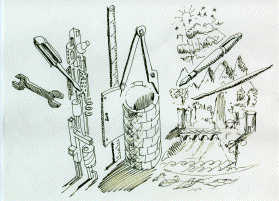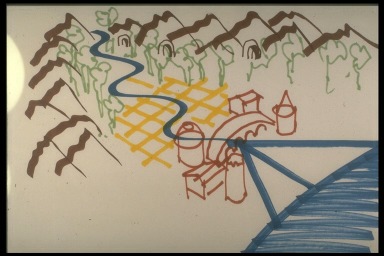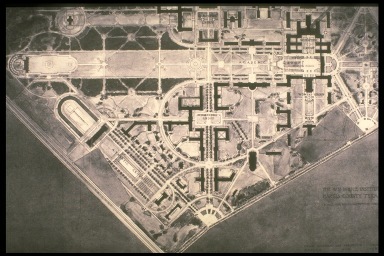
The River Valley |
| the "unofficial" Duncan Hall web site |
| Rice University |
| Houston, Texas, USA |
 |
|
 A critical underpinning of Outram's approach to creating communities is
the concept of a river valley civilization, or the "Republic of the Valley."
Many early civilizations formed around a single river valley that ran
from a source in the mountains to a delta and harbor in the sea.
This pattern occurred in many locales--Ancient Greece, Cypress, Egypt's Nile
valley, and Oregon's Willamette Valley.
The figure of a river valley occurs as an organizing
principle in many architectural settings: in Roman villas and Christian
churches, in Chinese cities and Indian Temples, in the designs of Le
Corbusier and James Stirling.
The recurring use of the river valley figure through the ages suggests
that it touches something fundamental about the organization of societies
and civilizations. This notion is central to Outram's vision of his work,
and his interpretation of the work of others.
To create a community, Outram designed into his building a river valley,
with its many diverse elements (mountains, sources, clearings, caves,
bridges, delta, and ocean).
The valley creates a single social space to bring together the diverse
community of computational engineering (applied mathematicians, computer
scientists, electrical engineers, and statisticians).
While his building is the first at Rice to create such a space in the
interior, the figure of a river valley is not new to Rice; Outram argues
that it is a central metaphor of Ralph Adams Cram's original plan for
the campus.
In Outram's view, the critical features of the
valley are its source, from which water flows,
the valley or canyon itself, and its delta. At the
head of the canyon, streams from multiple
sources may merge together. At the foot of
the canyon, one finds a bridge, like the bridge
of appearances found in a Gothic cathedral.
The delta is a place for cities, for commerce,
and for contact with other cultures. These
features are clearly present in his various
drawings of the "republic of the valley."
A critical underpinning of Outram's approach to creating communities is
the concept of a river valley civilization, or the "Republic of the Valley."
Many early civilizations formed around a single river valley that ran
from a source in the mountains to a delta and harbor in the sea.
This pattern occurred in many locales--Ancient Greece, Cypress, Egypt's Nile
valley, and Oregon's Willamette Valley.
The figure of a river valley occurs as an organizing
principle in many architectural settings: in Roman villas and Christian
churches, in Chinese cities and Indian Temples, in the designs of Le
Corbusier and James Stirling.
The recurring use of the river valley figure through the ages suggests
that it touches something fundamental about the organization of societies
and civilizations. This notion is central to Outram's vision of his work,
and his interpretation of the work of others.
To create a community, Outram designed into his building a river valley,
with its many diverse elements (mountains, sources, clearings, caves,
bridges, delta, and ocean).
The valley creates a single social space to bring together the diverse
community of computational engineering (applied mathematicians, computer
scientists, electrical engineers, and statisticians).
While his building is the first at Rice to create such a space in the
interior, the figure of a river valley is not new to Rice; Outram argues
that it is a central metaphor of Ralph Adams Cram's original plan for
the campus.
In Outram's view, the critical features of the
valley are its source, from which water flows,
the valley or canyon itself, and its delta. At the
head of the canyon, streams from multiple
sources may merge together. At the foot of
the canyon, one finds a bridge, like the bridge
of appearances found in a Gothic cathedral.
The delta is a place for cities, for commerce,
and for contact with other cultures. These
features are clearly present in his various
drawings of the "republic of the valley."
 Looking at Cram's plan for Rice, it is easy to see the valley that
Outram envisions. It has a source placed in what is now the stadium
parking lot, and a valley that flows from there to its delta in Founder's
Court. The implementation of the plan still follows this model.
Alice Pratt Brown Hall lies at the western end, in the mountain glade or
"round dance" under the dome of the sky--an appropriate figure for
the performance halls of the music school. In Cram's plan, a single, small,
central building sits like a boulder in the middle of the river; as
realized in Fondren Library, it is a dam that truncates the whole arrangement.
The buildings aligned along the axis--Physics, Sewall, Anderson, Rayzor,
the Student Center, Herring, and now, the Baker Institute--become the
canyon walls. The walls break to admit flow from tributary valleys to
the north and south. The Sallyport of Lovett Hall forms a gateway
underneath its bridge of appearances, leading to the delta that faces
eastward, toward the City of Houston.
In this iconographic view of the campus plan, even the oft-recounted
limerick about Lovett's office takes on new significance. Watkins
placed Edgar Odell Lovett's office above the Sallyport, where it
dominates the bridge. This placement implicitly underscored both his
central importance to the institution and his role as guardian and
protector in the interactions between the university and the adjacent city.
Appropriately, the current academic rituals of the institution both
recognize and reflect this river-valley myth.
Matriculation, the formal entry of a student into the University, is held on
the lawn of Founder's Court. Thus, students begin their academic journey
in the river's delta; they pass under the Sallyport's bridge and enter
the valley wherein they work and study. At the completion of their studies,
they graduate. Graduation is staged just inside the quadrangle, to the
west of Lovett Hall. The students receive their degrees and pass back
through the Sallyport to the delta and its harbor. They have spent their
time in the valley and are sent forth to use their new-found knowledge
in the commerce of the outside world.
Looking at Cram's plan for Rice, it is easy to see the valley that
Outram envisions. It has a source placed in what is now the stadium
parking lot, and a valley that flows from there to its delta in Founder's
Court. The implementation of the plan still follows this model.
Alice Pratt Brown Hall lies at the western end, in the mountain glade or
"round dance" under the dome of the sky--an appropriate figure for
the performance halls of the music school. In Cram's plan, a single, small,
central building sits like a boulder in the middle of the river; as
realized in Fondren Library, it is a dam that truncates the whole arrangement.
The buildings aligned along the axis--Physics, Sewall, Anderson, Rayzor,
the Student Center, Herring, and now, the Baker Institute--become the
canyon walls. The walls break to admit flow from tributary valleys to
the north and south. The Sallyport of Lovett Hall forms a gateway
underneath its bridge of appearances, leading to the delta that faces
eastward, toward the City of Houston.
In this iconographic view of the campus plan, even the oft-recounted
limerick about Lovett's office takes on new significance. Watkins
placed Edgar Odell Lovett's office above the Sallyport, where it
dominates the bridge. This placement implicitly underscored both his
central importance to the institution and his role as guardian and
protector in the interactions between the university and the adjacent city.
Appropriately, the current academic rituals of the institution both
recognize and reflect this river-valley myth.
Matriculation, the formal entry of a student into the University, is held on
the lawn of Founder's Court. Thus, students begin their academic journey
in the river's delta; they pass under the Sallyport's bridge and enter
the valley wherein they work and study. At the completion of their studies,
they graduate. Graduation is staged just inside the quadrangle, to the
west of Lovett Hall. The students receive their degrees and pass back
through the Sallyport to the delta and its harbor. They have spent their
time in the valley and are sent forth to use their new-found knowledge
in the commerce of the outside world.